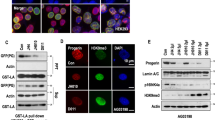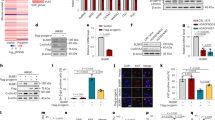Abstract
Several human progerias, including Hutchinson-Gilford progeria syndrome (HGPS), are caused by the accumulation at the nuclear envelope of farnesylated forms of truncated prelamin A, a protein that is also altered during normal aging1,2. Previous studies in cells from individuals with HGPS have shown that farnesyltransferase inhibitors (FTIs) improve nuclear abnormalities associated with prelamin A accumulation, suggesting that these compounds could represent a therapeutic approach for this devastating progeroid syndrome3. We show herein that both prelamin A and its truncated form progerin/LAΔ50 undergo alternative prenylation by geranylgeranyltransferase in the setting of farnesyltransferase inhibition, which could explain the low efficiency of FTIs in ameliorating the phenotypes of progeroid mouse models. We also show that a combination of statins and aminobisphosphonates efficiently inhibits both farnesylation and geranylgeranylation of progerin and prelamin A and markedly improves the aging-like phenotypes of mice deficient in the metalloproteinase Zmpste24, including growth retardation, loss of weight, lipodystrophy, hair loss and bone defects. Likewise, the longevity of these mice is substantially extended. These findings open a new therapeutic approach for human progeroid syndromes associated with nuclear-envelope abnormalities.
This is a preview of subscription content, access via your institution
Access options
Subscribe to this journal
Receive 12 print issues and online access
$209.00 per year
only $17.42 per issue
Buy this article
- Purchase on Springer Link
- Instant access to full article PDF
Prices may be subject to local taxes which are calculated during checkout




Similar content being viewed by others
References
Navarro, C.L., Cau, P. & Levy, N. Molecular bases of progeroid syndromes. Hum. Mol. Genet. 15 Suppl 2, R151–R161 (2006).
Scaffidi, P. & Misteli, T. Lamin A–dependent nuclear defects in human aging. Science 312, 1059–1063 (2006).
Young, S.G., Meta, M., Yang, S.H. & Fong, L.G. Prelamin A farnesylation and progeroid syndromes. J. Biol. Chem. 281, 39741–39745 (2006).
Kipling, D., Davis, T., Ostler, E.L. & Faragher, R.G. What can progeroid syndromes tell us about human aging? Science 305, 1426–1431 (2004).
Hennekam, R.C. Hutchinson-Gilford progeria syndrome: review of the phenotype. Am. J. Med. Genet. A. 140, 2603–2624 (2006).
Pendás, A.M. et al. Defective prelamin A processing and muscular and adipocyte alterations in Zmpste24 metalloproteinase–deficient mice. Nat. Genet. 31, 94–99 (2002).
Ramirez, C.L., Cadinanos, J., Varela, I., Freije, J.M. & López-Otín, C. Human progeroid syndromes, aging and cancer: new genetic and epigenetic insights into old questions. Cell. Mol. Life Sci. 64, 155–170 (2007).
Varela, I. et al. Accelerated ageing in mice deficient in Zmpste24 protease is linked to p53 signalling activation. Nature 437, 564–568 (2005).
Liu, B. et al. Genomic instability in laminopathy-based premature aging. Nat. Med. 11, 780–785 (2005).
Liu, Y., Rusinol, A., Sinensky, M., Wang, Y. & Zou, Y. DNA damage responses in progeroid syndromes arise from defective maturation of prelamin A. J. Cell Sci. 119, 4644–4649 (2006).
Espada, J. et al. Nuclear envelope defects cause stem cell dysfunction in premature-aging mice. J. Cell Biol. 181, 27–35 (2008).
Cadiñanos, J., Varela, I., López-Otín, C. & Freije, J.M. From immature lamin to premature aging: molecular pathways and therapeutic opportunities. Cell Cycle 4, 1732–1735 (2005).
Toth, J.I. et al. Blocking protein farnesyltransferase improves nuclear shape in fibroblasts from humans with progeroid syndromes. Proc. Natl. Acad. Sci. USA 102, 12873–12878 (2005).
Capell, B.C. et al. Inhibiting farnesylation of progerin prevents the characteristic nuclear blebbing of Hutchinson-Gilford progeria syndrome. Proc. Natl. Acad. Sci. USA 102, 12879–12884 (2005).
Mallampalli, M.P., Huyer, G., Bendale, P., Gelb, M.H. & Michaelis, S. Inhibiting farnesylation reverses the nuclear morphology defect in a HeLa cell model for Hutchinson-Gilford progeria syndrome. Proc. Natl. Acad. Sci. USA 102, 14416–14421 (2005).
Glynn, M.W. & Glover, T.W. Incomplete processing of mutant lamin A in Hutchinson-Gilford progeria leads to nuclear abnormalities, which are reversed by farnesyltransferase inhibition. Hum. Mol. Genet. 14, 2959–2969 (2005).
Fong, L.G. et al. A protein farnesyltransferase inhibitor ameliorates disease in a mouse model of progeria. Science 311, 1621–1623 (2006).
Yang, S.H. et al. A farnesyltransferase inhibitor improves disease phenotypes in mice with a Hutchinson-Gilford progeria syndrome mutation. J. Clin. Invest. 116, 2115–2121 (2006).
Whyte, D.B. et al. K- and N-Ras are geranylgeranylated in cells treated with farnesyl protein transferase inhibitors. J. Biol. Chem. 272, 14459–14464 (1997).
Rusinol, A.E. & Sinensky, M.S. Farnesylated lamins, progeroid syndromes and farnesyl transferase inhibitors. J. Cell Sci. 119, 3265–3272 (2006).
Konstantinopoulos, P.A. & Papavassiliou, A.G. Multilevel modulation of the mevalonate and protein-prenylation circuitries as a novel strategy for anticancer therapy. Trends Pharmacol. Sci. 28, 6–13 (2007).
Giraudo, E., Inoue, M. & Hanahan, D. An amino-bisphosphonate targets MMP-9–expressing macrophages and angiogenesis to impair cervical carcinogenesis. J. Clin. Invest. 114, 623–633 (2004).
Yamagata, T. et al. Effects of pravastatin in murine collagen-induced arthritis. Rheumatol. Int. 27, 631–639 (2007).
Sullivan, T. et al. Loss of A-type lamin expression compromises nuclear envelope integrity leading to muscular dystrophy. J. Cell Biol. 147, 913–920 (1999).
Demierre, M.F., Higgins, P.D., Gruber, S.B., Hawk, E. & Lippman, S.M. Statins and cancer prevention. Nat. Rev. Cancer 5, 930–942 (2005).
Greenwood, J., Steinman, L. & Zamvil, S.S. Statin therapy and autoimmune disease: from protein prenylation to immunomodulation. Nat. Rev. Immunol. 6, 358–370 (2006).
Roelofs, A.J., Thompson, K., Gordon, S. & Rogers, M.J. Molecular mechanisms of action of bisphosphonates: current status. Clin. Cancer Res. 12, 6222s–6230s (2006).
Issat, T. et al. Potentiated antitumor effects of the combination treatment with statins and pamidronate in vitro and in vivo. Int. J. Oncol. 30, 1413–1425 (2007).
Schmidmaier, R., Simsek, M., Baumann, P., Emmerich, B. & Meinhardt, G. Synergistic antimyeloma effects of zoledronate and simvastatin. Anticancer Drugs 17, 621–629 (2006).
Blobel, G. & Potter, V.R. Nuclei from rat liver: isolation method that combines purity with high yield. Science 154, 1662–1665 (1966).
Acknowledgements
We thank G. Morris (Centre for Inherited Neuromuscular Disease, RJAH Orthopaedic Hospital) for antibody 4A7. We thank X.S. Puente, C.L. Ramírez, A.F. Braña, P. Bourgeois, C. Massart, F. Canals, M. Barbacid, C. Guerra, K. Tryggvason, C. Stewart and G. Velasco for helpful comments and advice and F. Rodríguez, S. Alvarez, E. Francezon, L. Espinosa and I. Bocaccio for excellent technical assistance. This work was supported by grants from Ministerio de Educación y Ciencia-Spain, Fundación La Caixa, Fundación M. Botín, Institut National de la Santé et de la Recherche Médicale-France, Agence Nationale de la Recherche-France, Association Française contre les Myopathies and the European Union (FP6 CancerDegradome and FP6 Eurolaminopathies). The Instituto Universitario de Oncología is supported by Obra Social Cajastur-Asturias.
Author information
Authors and Affiliations
Contributions
I.V., A.P.U., J. Cadiñanos, F.G.O. and J.M.P.F. carried out animal experiments. S.P., C.L.N., P.C., N.F., I.V. and A.P.U. performed cell-culture based studies. I.V., J. Cadiñanos, J.M.P.F. and M.F.S. carried out mass spectrometry experiments. F.d.C. and J. Cobo conducted micro-CT analysis. C.L.-O., J.M.P.F., P.C. and N.L. were responsible for designing and supervising the project and writing the manuscript.
Corresponding author
Supplementary information
Supplementary Text and Figures
Supplementary Figs. 1–7 (PDF 4377 kb)
Rights and permissions
About this article
Cite this article
Varela, I., Pereira, S., Ugalde, A. et al. Combined treatment with statins and aminobisphosphonates extends longevity in a mouse model of human premature aging. Nat Med 14, 767–772 (2008). https://doi.org/10.1038/nm1786
Received:
Accepted:
Published:
Issue Date:
DOI: https://doi.org/10.1038/nm1786
This article is cited by
-
Effect of bisphosphonates and statins on the in vitro radiosensitivity of breast cancer cell lines
Pharmacological Reports (2024)
-
Progeria—a Rare Genetic Condition with Accelerated Ageing Process
Applied Biochemistry and Biotechnology (2023)
-
Individual Response to Radiation of Individuals with Neurofibromatosis Type I: Role of the ATM Protein and Influence of Statins and Bisphosphonates
Molecular Neurobiology (2022)
-
Nuclear organization and regulation of the differentiated state
Cellular and Molecular Life Sciences (2021)
-
Progerinin, an optimized progerin-lamin A binding inhibitor, ameliorates premature senescence phenotypes of Hutchinson-Gilford progeria syndrome
Communications Biology (2021)



